"It’s not just a sausage in a bun; it’s a beautiful blank canvas. It’s a hot dog, which is a foodstuff eaten worldwide. Here are 40 distinctive varieties from around the globe — from iconic NYC 'dirty water dogs' to fully loaded South American street-cart dogs to Japanese octo-dogs. There is a tubesteak out there for every craving that ever was."
Get Started for FREE
Sign up with Facebook Sign up with X
I don't have a Facebook or a X account

 Your new post is loading... Your new post is loading...
 Your new post is loading... Your new post is loading...

Keone Sinnott-Suardana's curator insight,
June 22, 2016 10:21 PM
Nicole Canova's curator insight,
May 1, 2018 10:30 PM
China has one of the fastest-growing economies in the world: but at what cost? They make themselves competitive in global markets by delivering goods and services at low prices, which they achieve through under-paying workers, not using resources to ensure workers' safety, and polluting the environment by ignoring protocols for safely disposing of waste products, which costs time and money. The result is air that is unsafe to breathe, millions of people and animals with poisoned water supplies, and land that cannot be farmed.

Matt Danielson's curator insight,
December 12, 2018 3:39 PM
CHina's pollution issues are pretty bad, possibly the worst polluter in the world. The air quality can be so terrible it reminds me of Industrial revolution London, except Chinese cities are even worse. Not just air pollution from smoke stacks but land pollution from dirty mining and water pollution in rivers from factories all play key roles in China's pollution problem. Some estimates put the number as high as a million Chinese deaths per a year attributed to pollution. This article does a good job of breaking down the pollution issue into simple terms.

Fiqah Nasrin's curator insight,
January 27, 2014 8:37 AM
From this article i get to know that a child who born to an educated mother will benefit more than a child who born to mothers without an education. Quite a number of women in the world are without a proper education. Is it fair to women without a proper education to be condemn to be told that their child will do poorly rather than a child of an educated mothers. Their child would eventually suceed through hard work and support from their family.
Zemus Koh's curator insight,
January 27, 2014 10:11 AM
From this infographic, I can see the importance of education and how it can impact us in our lives. Education is key as it can help us in many ways such as being able to teach our offspings survival skills and also help us to earn more so that we can bring up a family and support them. However important education is, it still comes with a price. As such, many are deprived of this oppurtunity to be educated even though education is somewhat considered a neccessity. Other benefits of education to women include a lesser chance of contracting STDs and also having a higher chance to immunize their children compared to non-educated women. Since education is a key to survival and an important part in our lives, why is it that no effort is made to promote this or to fund more projects that help the less fortunate to get a chance to be educated? 
Fiqah Nasrin's curator insight,
February 23, 2014 7:28 AM
This article tells me that a child who born to an educated mother will benefit more than a child who born to mothers without an education. Quite a number of women in the world are without a proper education. Is it fair to women without a proper education to be condemn to be told that their child will do poorly rather than a child of an educated mothers. Their child would eventually succeed through hard work and support from their family. It stated that most children who drop out from school are girls and most of the people cant read live in developing countries. In this century i am sure that proper education are given to those who could not afford it as everyone want to succeed. I think that it does not matter if a child's mother is without an education as they can succeed if they work hard and opportunity is given to them.
Geography's curator insight,
July 6, 2015 2:21 PM
While we often think of the Chicago Dog in the midwest, there's quite a variety out there! Which would you try and which is your favorite? 
Jose Soto's curator insight,
August 5, 2015 9:50 PM
The 4th of July is the day of Coney Island's Hot Dog eating contest and the quintessential day to have a barbeque in the United States. Some see the hot dog as a mere symbol of the uniformity of globalized culture in the 21st century that diffused out from the United States. There is much more to be seen in the globalization of food. Yes, the global goes to the whole world, but distinct places make this global cultural trait intensely local. For example the hot dogs in Cincinnati are famous for being topped with chili and an obscene quantity of cheese, but in Costa Rica, I learned to love eating hot dogs deep fried, topped with cabbage, mayo and ketchup, just like the Ticos. Food is but one example of this phenomena known as glocalization, where diffusion and divergence keep the world both global and local.
Tags: food, culture, diffusion, globalization, consumption. 
Colleen Blankenship's curator insight,
February 14, 2019 12:03 PM
What are the cultural connections of the hot dogs, toppings, and buns with the areas with which they are associated?

Henk Trimp's curator insight,
June 12, 2015 6:26 AM
Questionable, but intriguing contribution to an ever continuing discussion... 
Kaitlyn Evans's comment,
July 30, 2015 5:24 AM
I'm not sure if I believe everything this video stated, however I think it is a good topic to analyze. I think it would be interesting to see how the rich countries became rich. They can't just have started on top. I also believe the rich countries abuse the poor countries because we can get goods/minerals/just about anything for a small price and then sell it in the rich country for much more.

Luis Cesar Nunes's curator insight,
March 31, 2015 7:48 AM
We are becoming obsolete as a Charlie Chaplin film, perpetuate the grace of the silent film as the industry is all forward-talkie. 
Colleen Blankenship's curator insight,
March 30, 2016 12:11 PM
The relatively recent decline of music industry, as well as the newspaper industry, are good examples to teach the concept of creative destruction. As jobs are created through new emerging technologies, older jobs will be rendered obsolete and be 'destroyed.' While many bemoan the loss of particular jobs as regrettable, it is a part of globalization of economic geography that as jobs are created with new technologies, other jobs disappear. Indoor plumbing meant the death of the water-carrying guilds (while I might be sad they lost their jobs, I'm keeping my plumbing). The trick is to make these transitions smooth and to prepare the labor force to have skills that the new economy will demand so that individual families and workers aren't casualties of this 'creative destruction' process. Tags: economic, labor, globalization, unit 6 industry.
BrianCaldwell7's curator insight,
April 5, 2016 8:12 AM
The relatively recent decline of music industry, as well as the newspaper industry, are good examples to teach the concept of creative destruction. As jobs are created through new emerging technologies, older jobs will be rendered obsolete and be 'destroyed.' While many bemoan the loss of particular jobs as regrettable, it is a part of globalization of economic geography that as jobs are created with new technologies, other jobs disappear. Indoor plumbing meant the death of the water-carrying guilds (while I might be sad they lost their jobs, I'm keeping my plumbing). The trick is to make these transitions smooth and to prepare the labor force to have skills that the new economy will demand so that individual families and workers aren't casualties of this 'creative destruction' process. Tags: economic, labor, globalization, unit 6 industry.

HG Académie de Rennes's curator insight,
January 31, 2015 1:56 AM
Un site d'une grande simplicité d'utilisation bien qu'en anglais. Le principe est de choisir deux pays dans un menu déroulant pour en comparer les principaux indicateurs de développement sous la forme de petites infographies très pédagogiques. Dernière information sur ce site, les statistiques utilisées proviennent des bases de données open source de la CIA américaine. 
Brian Wilk's curator insight,
February 7, 2015 7:51 PM
After studying this comparison tool and using it to find the best of the best and worst of the worst, I picked out some highlights I'd like to share. Monaco is clearly the place to be born, earn, and live. When compared to the USA, the infant mortality rate is 71% less, the life expectancy is 10 years longer @ 84, and you'll earn 62% more money, no doubt because you have ten more years in which to do so. I believe the stats may be skewed a bit in this country comparison as the very rich live there and they have access to the best medical care, and probably don't have very many infants with them when they make the move from elsewhere, hence the low infant mortality rate. Austria is not a bad second choice as you are 33% less likely to be unemployed. On a sobering note, the life expectancy if you live in Namibia is only 52! Yikes, I'm already 53... It's far worse however in Swaziland. The life expectancy is sadly only 50.5 years and you are 44 times more likely to have AIDS than if you lived here. 26.5% of the population has AIDS! Be thankful for where you live and stop complaining, it's far worse on average in nearly all other countries. 
Monika Fleischmann's curator insight,
February 15, 2015 4:59 AM
Seth Dixon's insight:
Did you know that with 1/30th the territory of the United States, Norway still has over 25% more coastline? I didn't either until I compared Norway to the United States using My Life Elsewhere. This site is designed allow United States students to imagine how their lives might be different if they were born in a different part of the world. Students would probably die 21 years earlier if they were born in Liberia and 11 times more likely to have died in infancy. Students would be 43.8% less likely to grow up and be unemployed and have 36.3% less babies if they were born in Taiwan. This side-by-side format is a great way to help students help make these statistics real and meaningful. One major drawback: this site only allows users to compare a country to the United States. If you prefer to have students compare, say Cuba to the United Arab Emirates, I would recommend that you try If It Where My Home.
Steven McGreevy's curator insight,
March 7, 2014 4:49 AM
Fat and Lean nations... let's see if it sticks... 
Joanne Wegener's curator insight,
March 7, 2014 5:03 AM
Fat or Lean - what sort of world do we live in An interesting discussion on the way we perceive and label the world. 
Ma. Caridad Benitez's curator insight,
March 11, 2014 10:15 AM
Hoy en día poca claridad de dónde exactamente queda y quiénes son? |
Benjamin Jackson's curator insight,
December 13, 2015 7:37 PM
it is the distribution of resources which has made the middle east as important as it is. it is interesting to note that this is also one of the most politically backwards places on the globe.
Adam Deneault's curator insight,
December 14, 2015 5:40 PM
This use of oil world wide is highly uneven. Maybe there are a lot of wars because of this. We are consuming twenty million barrels of oil a year, that is a lot. The middle east hosts over sixty percent of what oil is left remaining and with countries setting the prices of oil, of course some countries will definitely have more or less. those countries with money will have the oil, those without will not. Developed countries will be able to afford and undeveloped countries will not get what they want or need.
BrianCaldwell7's curator insight,
April 5, 2016 8:17 AM
Natural resources are not evenly distributed...this distribution pattern impacts global economics, industrialization, development and politics tremendously. Tags: industry, economic, energy, resources.

Alisha Meyer's curator insight,
March 24, 2016 9:04 AM
Our world is changing, that is inevitable. It's how we decide to use the technology and knowledge we now have to better ourselves or destroy ourselves.

Kelsey McIntosh's curator insight,
January 18, 2018 7:46 PM
This chart is pretty straight forward, yet it clearly lays out the difference between 20th and 21st century Globalization patterns. Through modern invention and progress in technology the world has become a place where connections can be created at the speed of light. Through technology, the world no longer has to wait for the physical movement of goods and ideas, at the touch of a button information can be in anyone's hands
Nicole Canova's curator insight,
May 1, 2018 10:48 PM
Globalization is a process that has been occurring for centuries. However, modern technology is making globalization faster than ever, and has enabled globalization to shift to a more information- and knowledge-based exchange rather than ever as well thanks to the Internet.

Chris Costa's curator insight,
November 15, 2015 2:18 PM
I was unpleasantly surprised to learn that all these statements are indeed true. Reading about the struggles India has endured with the lack of indoor plumbing many of its people must endure made me think of a previous article I had read about the "Two Mexico's." Rapid development in certain areas for certain people has revolutionized the standard of living for some, but the persistence of corruption has lead to economic lag for many of the people of both nations, meaning significant portions of the population are being left behind during this period of development. The sanitation and plumbing systems of inca are woefully inadequate for a country of over a billion people, subtracting from the leaps that have been made in other areas. The dangers faced by women as a result of the lack of indoor plumbing was a surprise, although it does make sense. Millions of Indian women have to resort to walking to communal bathrooms, oftentimes at night on solitary trips, which leaves them vulnerable to the kids of sexual assault that have plagued Indian media. I hope for the sake of the Indian people that improvements in the rates of indoor plumbing in the country continue to be made. 
Matt Ramsdell's curator insight,
December 14, 2015 2:46 PM
One thing about this issue is the fact that most of the people living in the area dont have the proper sanitation. Many of the issues that they face are a lack of government and funding and jobs. However the issue in India is the worst within the world. China has a huge lack of sanitation but in India the situation is much worse.
Adam Deneault's curator insight,
December 14, 2015 6:38 PM
Something like this just disgusts me, first off there are more cell phones in this country than toilets... how does a government allow that to happen? Clearly, the answer is, they must not care because there is lack of governmental help. These people do not have toilets in there houses, they have to go down the street to a public restroom where thousands of people go a day both sick and healthy, so there are probably terrible sicknesses running rampant. Hopefully for them, they do not get a life threatening disease that will kill off the population.

Bob Beaven's curator insight,
January 29, 2015 2:27 PM
This article is interesting from a geographic and social perspective, because the overhead pictures show just how much we alter the land with our prisons. What is really interesting is how the US has less than five percent of the world's population but has one quarter of its prisoners. Because of this, it can be inferred that the country has many prisons. Yet, what astonished me about the prisons is that they seem to be out in the middle of nowhere. The buildings seem expansive on the landscape and dominate it. It just makes me wonder, how much does the United States spend on building and up-keeping these complexes. 
Incarceration's curator insight,
May 8, 2015 1:11 AM
This article explores a graphic representation of the quantity and volume of prisons throughout the United States. The project has no figures, statistics, or words - the pictures stand on their own as statements about the growing amount and size of prisons across the country. The photos show many rural prisons that house prisoners from urban areas, which changes both the areas where the prisons are and the areas that the inmates came from.
The photos are an intriguing visual of the money and materials put into prison systems in the United States. The photographer (Josh Begley) noted that upon seeing all the images together, the thing that stood out to him was that there were baseball fields in almost all of them. He says, "the baseball field mimicked the form about these buildings as well. There was something very American about it when I first saw it."
It's surprising to see how much material is necessary to, as the article described it, "warehouse" people. While prisons do more than just house inmates, seeing a visual representation of all the money put into prisons in the United States makes me wonder whether it could be better spent on reformed versions of prisons, rather than on maintaining the ones we already have and the new ones just like those that are currently being constructed.
- K 
Lydia Tsao's curator insight,
May 26, 2015 2:43 AM
These picture demonstrate the power of satellite imagery and technology perfectly. While I am amazed by the sheer beauty in spatial organization and design by these prisons, I am horrified at the maps incarcerations that are occurring in America, especially the mass incarceration of poverty stricken minorities in America. Prisons demonstrate a larger social issue than what I previously thought. I never knew that such a thing as prison-based gerrymandering could even exist. Prisons demonstrate economic and political problems as well. With more prisons, state must allocate more of their budget to supporting these facilities. The fact that so many prisons are being built demonstrate a larger problem in the political world, and that maybe there is an issue with the justice system. Fixing the system would allow for states to allocate more money that would have been use on supporting prisons to supporting education and helping those who are less privileged.

Kevin Nguyen's curator insight,
October 7, 2015 1:17 PM
These vessels are specifically made to increase more profit and is a symbol of economic power for trades between Europe and Asia. They aim to increase containment of cargo so it is more efficient and time consuming of going back to fourth. However, they forced ports to become bigger to compete and keep up with these new inventions. These ships are getting too big and are only able to transit through the Suez canal and cannot go through the Panama. This lead to the Chinese expanding their reach to Nicaragua and building a larger canal to be able to pass through Central America. 
Alex Smiga's curator insight,
March 14, 2016 7:42 PM
These containers are symbols of global commerce that enable economies of scale to be profitable and the outsourcing of so many manufacturing jobs to developing countries. The invention of these containers have changed the geography of global shipping and the vast majority of the world's largest ports are now in East Asia. Today though, the biggest container ships are too big to go through the Panama Canal, encouraging China to build a larger canal through Nicaragua.
BrianCaldwell7's curator insight,
April 5, 2016 8:18 AM
These containers are symbols of global commerce that enable economies of scale to be profitable and the outsourcing of so many manufacturing jobs to developing countries. The invention of these containers have changed the geography of global shipping and the vast majority of the world's largest ports are now in East Asia. Today though, the biggest container ships are too big to go through the Panama Canal, encouraging China to build a larger canal through Nicaragua. Tags: transportation, globalization, diffusion, industry, economic. |








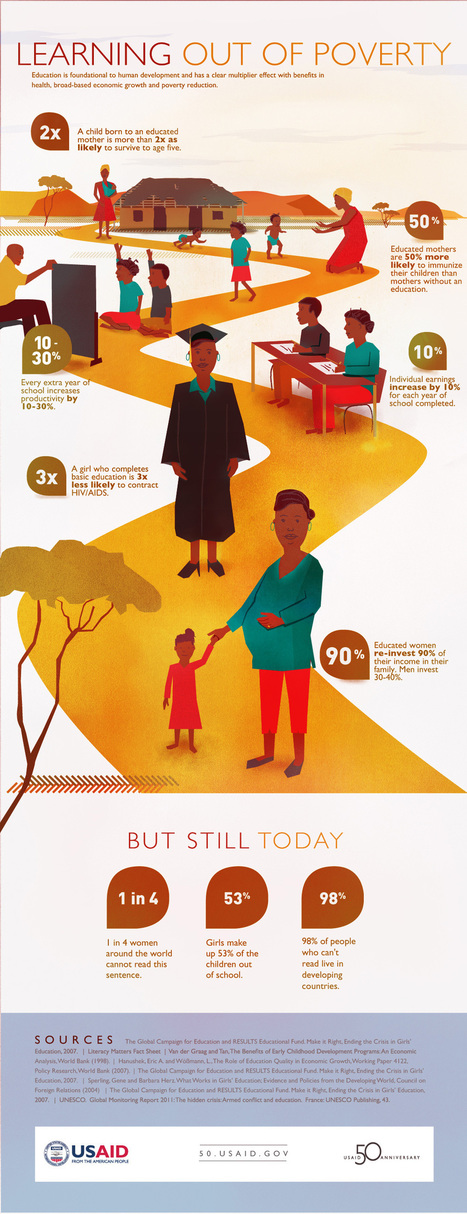


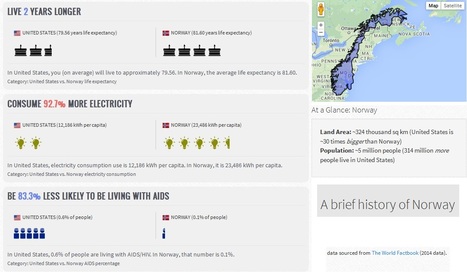



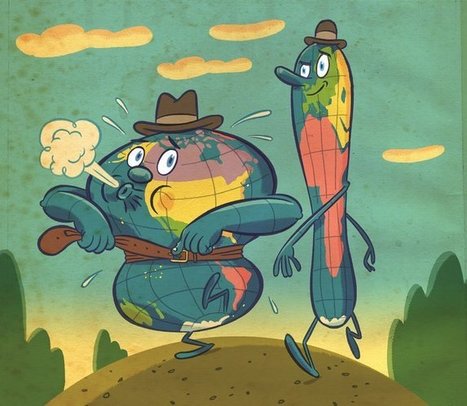



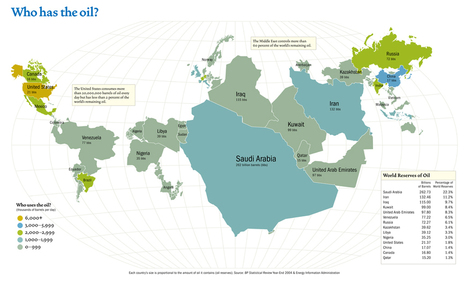
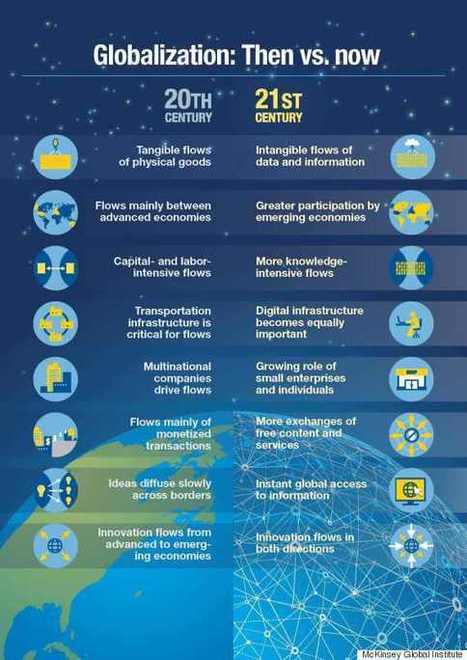


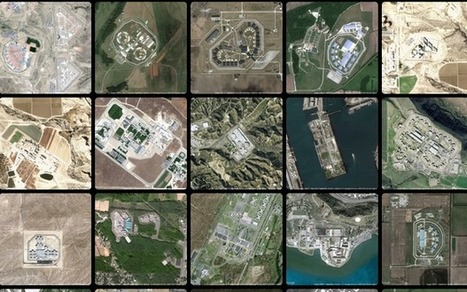
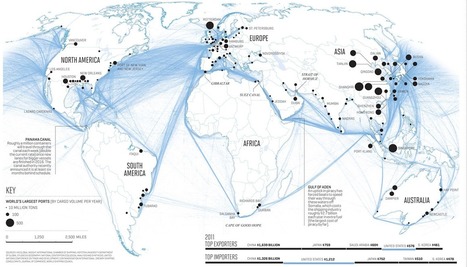








While we often think of the Chicago Dog in the midwest, there's quite a variety out there! Which would you try and which is your favorite?
The 4th of July is the day of Coney Island's Hot Dog eating contest and the quintessential day to have a barbeque in the United States. Some see the hot dog as a mere symbol of the uniformity of globalized culture in the 21st century that diffused out from the United States. There is much more to be seen in the globalization of food. Yes, the global goes to the whole world, but distinct places make this global cultural trait intensely local. For example the hot dogs in Cincinnati are famous for being topped with chili and an obscene quantity of cheese, but in Costa Rica, I learned to love eating hot dogs deep fried, topped with cabbage, mayo and ketchup, just like the Ticos. Food is but one example of this phenomena known as glocalization, where diffusion and divergence keep the world both global and local.
Tags: food, culture, diffusion, globalization, consumption.
What are the cultural connections of the hot dogs, toppings, and buns with the areas with which they are associated?